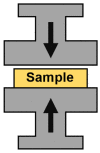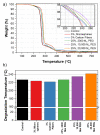Characterization of Polyhydroxybutyrate-Based Composites Prepared by Injection Molding
- PMID: 34960995
- PMCID: PMC8704503
- DOI: 10.3390/polym13244444
Characterization of Polyhydroxybutyrate-Based Composites Prepared by Injection Molding
Abstract
The waste generated by single-use plastics is often non-recyclable and non-biodegradable, inevitably ending up in our landfills, ecosystems, and food chain. Through the introduction of biodegradable polymers as substitutes for common plastics, we can decrease our impact on the planet. In this study, we evaluate the changes in mechanical and thermal properties of polyhydroxybutyrate-based composites with various additives: Microspheres, carbon fibers or polyethylene glycol (2000, 10,000, and 20,000 MW). The mixtures were injection molded using an in-house mold attached to a commercial extruder. The resulting samples were characterized using microscopy and a series of spectroscopic, thermal, and mechanical techniques. We have shown that the addition of carbon fibers and microspheres had minimal impact on thermal stability, whereas polyethylene glycol showed slight improvements at higher molecular weights. All of the composite samples showed a decrease in hardness and compressibility. The findings described in this study will improve our understanding of polyhydroxybutyrate-based composites prepared by injection molding, enabling advancements in integrating biodegradable plastics into everyday products.
Keywords: biodegradable plastics; compounding; injection molding; polyhydroxybutyrate; polymer composites.
Conflict of interest statement
The authors declare no conflict of interest.
Figures










References
-
- Williams M., Gower R., Green J., Whitebread E., Lenkiewicz Z., Schröder P. No Time to Waste: Tackling the Plastic Pollution Crisis before It’s Too Late. Institute of Development Studies; Falmer, UK: 2019.
LinkOut - more resources
Full Text Sources

